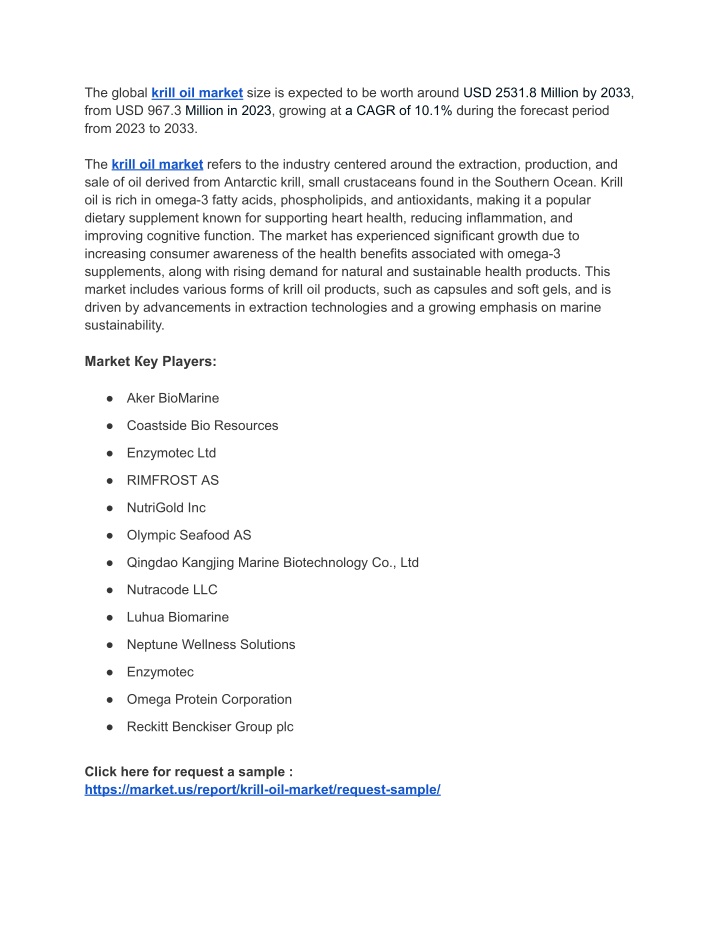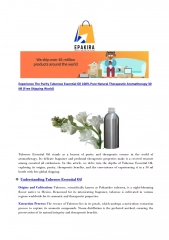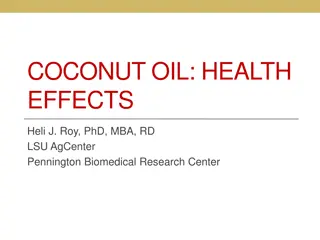
Krill Oil Market
The global krill oil market size is expected to be worth around USD 2531.8 Million by 2033, from USD 967.3 Million in 2023, growing at a CAGR of 10.1% during the forecast period from 2023 to 2033.nClick here for request a sample : //market.us/rep
Download Presentation

Please find below an Image/Link to download the presentation.
The content on the website is provided AS IS for your information and personal use only. It may not be sold, licensed, or shared on other websites without obtaining consent from the author. If you encounter any issues during the download, it is possible that the publisher has removed the file from their server.
You are allowed to download the files provided on this website for personal or commercial use, subject to the condition that they are used lawfully. All files are the property of their respective owners.
The content on the website is provided AS IS for your information and personal use only. It may not be sold, licensed, or shared on other websites without obtaining consent from the author.
E N D
Presentation Transcript
The global krill oil market size is expected to be worth around USD 2531.8 Million by 2033, from USD 967.3 Million in 2023, growing at a CAGR of 10.1% during the forecast period from 2023 to 2033. The krill oil market refers to the industry centered around the extraction, production, and sale of oil derived from Antarctic krill, small crustaceans found in the Southern Ocean. Krill oil is rich in omega-3 fatty acids, phospholipids, and antioxidants, making it a popular dietary supplement known for supporting heart health, reducing inflammation, and improving cognitive function. The market has experienced significant growth due to increasing consumer awareness of the health benefits associated with omega-3 supplements, along with rising demand for natural and sustainable health products. This market includes various forms of krill oil products, such as capsules and soft gels, and is driven by advancements in extraction technologies and a growing emphasis on marine sustainability. rk t l r : Aker BioMarine Coastside Bio Resources Enzymotec Ltd RIMFROST AS NutriGold Inc Olympic Seafood AS Qingdao Kangjing Marine Biotechnology Co., Ltd Nutracode LLC Luhua Biomarine Neptune Wellness Solutions Enzymotec Omega Protein Corporation Reckitt Benckiser Group plc Click here for request a sample : https://market.us/report/krill-oil-market/request-sample/
Product Type Analysis: As of 2023, liquids led the krill oil market with over 62.6% share due to their ease of consumption, often added to beverages or taken directly. Liquid Krill Oil, beneficial for infants, is anticipated to see high demand. The market is segmented into soft gels and capsules. Soft gels are favored for their smooth texture and ease of swallowing, expected to surge in application. Capsules are valued for protecting sensitive ingredients, offering unique combinations, and reducing GI irritation, which will drive demand in this segment. Application Analysis: In 2023, dietary supplements dominated the krill oil market, capturing over 71.7% share due to the health benefits of omega-3 polyunsaturated fatty acids. Demand is rising in developed countries like the U.S. and France due to increased health awareness. The inclusion of omega-3 in infant formulas is supported by regulations. DHA and EPA, known for cardiovascular benefits, will boost market growth. Industry expansion is expected due to significant investments from companies like GlaxoSmithKline and increased spending in the pharmaceutical sector in countries like China, India, and others in Southeast Asia. Distribution Channel Analysis: In 2023, supermarkets and hypermarkets led the krill oil market with over 38.3% share, providing consumers with convenient access and a broad product range. Drug stores and pharmacies attracted health-conscious customers with krill oil supplements. Online retailers offered a convenient and diverse selection, making them a popular choice for consumers. The dominance of supermarkets and hypermarkets underscores their role in making krill oil products easily accessible to shoppers. Key Market Segments: By Product Type Liquids Soft gels Capsules By Application Dietary Supplements Animal Feed Pharmaceuticals
Functional Food & Beverages Other Applications By Distribution Channel Supermarkets/Hypermarkets Drug Stores & Pharmacies Online Retailers Others Drivers: Health awareness about krill oil's benefits, like supporting cardiovascular health and reducing inflammation, is a major driver. Increasing consumer demand for omega-3-rich supplements boosts market growth. The inclusion of krill oil in functional foods and beverages for its nutritional value also contributes. Its use in pharmaceuticals due to potential therapeutic properties further fuels market expansion. Various distribution channels, such as supermarkets, pharmacies, and online retailers, enhance accessibility and market growth. Restraints: The krill oil market faces challenges, including sustainability concerns and environmental impact from krill harvesting. Overfishing in the Antarctic raises worries about the ecological balance, prompting calls for sustainable practices. Additionally, the higher cost of krill oil compared to other omega-3 supplements may deter some consumers, limiting market expansion, especially in regions where affordability is a priority. Opportunities: Opportunities in the krill oil market include growing consumer demand for natural and sustainable supplements. Health-conscious and environmentally aware consumers prefer products from sustainable marine resources like krill oil. Innovation in the nutraceutical industry, with new formulations and delivery systems, can cater to specific health needs and preferences. Expanding health and wellness trends in various regions offer significant market growth potential. Challenges: Challenges include the high dependency on krill as a primary source, risking supply chain disruptions due to overfishing or environmental changes. Regulatory complexities and quality standards in the nutraceutical industry pose hurdles for manufacturers, making
compliance costly and demanding. Consumer perception issues, misconceptions about krill oil's efficacy and sustainability compared to fish-derived omega-3s, and price fluctuations due to supply issues and economic uncertainties also impact market stability and demand.






















